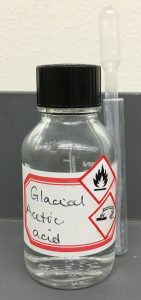Do not remove or deface the original manufacturer’s labels while the original substance is still inside. If the label becomes damaged then contact the Stockroom Manager for help in obtaining a replacement label.
By June 1, 2016, all containers that are received from chemical manufacturers/suppliers will have the following six required GHS label elements attached to the container:
- Product Identifier: This can be (but is not limited to) the chemical name, code number or batch number
- Supplier Info (Name, Address, and Telephone Number)
- Signal Word: Indicates the relative severity of the hazard. There are only two words used as Signal Words: “Danger” and “Warning.” Within a specific Hazard Class, “Danger” is used for the more severe hazards and “Warning” is used for the less severe hazards.
- Pictogram(s)
- Hazard Statement(s)
- Precautionary Statement(s): Precautionary Statements describe recommended measures (including PPE) that should be taken to minimize or prevent adverse effects resulting from exposure to the hazardous chemical or improper storage or handling.
- There are four types of Precautionary Statements:
- Prevention (guideline to minimize exposure; e.g., “Wear eye/face protection”)
- Response (instructions in case of accidental spillage or exposure; emergency response; and first-aid)
- Storage
- Disposal
- There are four types of Precautionary Statements:
Containers that Do Not Need Labels
-
Immediate-Use Containers that are under the direct control of one individual do not need a label if:
- You are the only person using it, AND
- You do not leave the container unattended, AND
- The container is emptied at the end of your work shift or research procedure (whichever time frame is shortest).
- If you leave for lunch, or to attend/teach class, or even if nature calls, then the container must be labeled.
- Reaction Vessels or other Similar Containers:
- These must have a label/sign posted nearby that allows an observer to understand the container’s contents and hazards.
Secondary Chemical Containers (e.g., squirt bottle, non-original screw-top bottle, vials, flasks, etc.) must have a means of communicating (1) their contents and (2) the hazards of those contents, either on the container or in the area where the container is stored/used.
Use these methods to label your secondary chemical containers:

You must be logged in to post a comment.